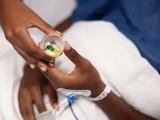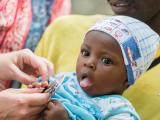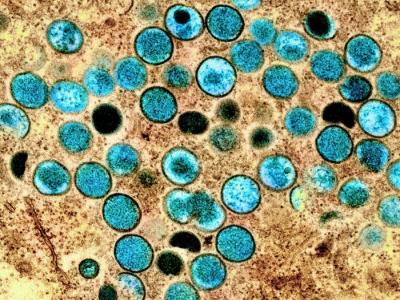The results of a randomized clinical trial suggests testing children who present with symptoms of acute sinusitis for three specific nasal bacterial pathogens may be a strategy for reducing unnecessary antibiotic use.
The results, published today in JAMA, showed that children without the nasopharyngeal pathogens did not benefit from antibiotics as much as children in whom the pathogens were detected. The authors of the study estimate that if children with symptoms of acute sinusitis were tested for these pathogens, unnecessary antibiotic use could be significantly reduced.
The study also found that the effects of antibiotic treatment did not depend on the color of nasal discharge, a finding that overturns a long-held belief that yellow- or green-colored discharge indicates a bacterial infection.
Identifying kids with bacterial infections
For the trial, a team led by investigators from the University of Pittsburgh enrolled children ages 2 to 11 years with acute sinusitis based on clinical criteria. The trial was conducted from February 2016 to April 2022 and included children treated at primary care offices connected to 6 US healthcare institutions.
Acute sinusitis is the one of the most common indications for antibiotic use in children, but in many cases the symptoms overlap with those of uncomplicated viral upper respiratory tract infection, which doesn't require antibiotics. The aim of the trial was to test whether children who aren't colonized with Streptococcus pneumoniae, Haemophilus influenzae, or Moraxella catarrhalis in their nasopharynx—and therefore are less likely to have a bacterial infection—are less likely to benefit from antibiotics than children who are colonized with those pathogens.
The lead investigator says one of the frustrations with acute sinusitis is that diagnosis is based on the severity and duration of symptoms.
"For an ear infection, we can look inside the ear; for pneumonia, we listen to the lungs. But for sinusitis, we have nothing to go on from a physical exam," Naider Shaikh, MD, a pediatrician at the University of Pittsburgh Medical Center Children's Hospital of Pittsburgh, said in a press release. "That was very unsatisfying to me."
The other hypothesis the investigators wanted to test was whether children with clear nasal discharge, as opposed to green or yellow discharge, are less likely to benefit from antibiotics.
To test these hypotheses, Shaikh and his colleagues assigned 515 children, based on the presence or absence of yellow or green nasal discharge, to receive a 10-day course of either oral amoxicillin and clavulanate or matching placebo. Nasopharyngeal specimens were obtained for bacterial culture from all enrolled children at the beginning and end of the study.
The primary outcome of the trial was symptom burden based on daily symptom scores on a validated scale (a range of 0 to 40) during the 10 days after diagnosis. Secondary outcomes included treatment failure, adverse events, and resource use by families.
A total of 510 children (64% ages 2 to 5; 54% male; 52% White) were included in the final analysis. Seventy-one percent had the bacterial pathogens of interest in their nasopharynx at the time of enrollment, and 67% had colored nasal discharge.
Overall, the children in the antibiotic arm fared better, with lower mean symptom scores (9.04; 95% confidence interval [CI], 8.71 to 9.37) compared with the placebo arm (10.60; 95% CI, 10.27 to 10.93) and a shorter time to symptom resolution (7 days vs 9 days). More children in the amoxicillin and clavulanate group, however, had clinically significant diarrhea compared with the placebo group (11.4% vs 4.7%).
Our study suggests that only half of these kids see an improvement in symptoms with antibiotic use, so by identifying who they are, we could greatly reduce unnecessary antibiotic use.
But for the children who were colonized with the bacterial pathogens of interest, the between-group difference in mean symptom scores (–1.95; 95% CI, –2.40 to –1.51) was much larger than it was for children without the nasopharyngeal pathogens (–0.88; 95% CI, –1.63 to –0.12). The effect of antibiotics did not differ significantly between subgroups defined by the presence or absence of colored nasal discharge.
An additional exploratory analysis found that most of the observed benefit from antibiotics was linked to the presence of H influenzae or S pneumoniae, which were found in 53% of the enrolled children. The between-group difference in symptoms scores was 0.28 (95% CI, –0.66 to 1.22) in children without H influenzae and S pneumoniae compared with –1.96 (95% CI, –2.64 to 1.28) in those with the pathogens.
Given the side effects that antibiotics can have and the role that antibiotic overuse plays in promoting antibiotic resistance, Shaikh said the results highlight the importance of determining which kids with sinusitis really need antibiotics.
"Five million kids in the U.S. get prescribed antibiotics for sinusitis each year," he said. "Our study suggests that only half of these kids see an improvement in symptoms with antibiotic use, so by identifying who they are, we could greatly reduce unnecessary antibiotic use."
A potential paradigm shift
Shaikh and his colleagues say that while it would represent a paradigm shift, making antibiotics contingent upon a positive test result for these pathogens could be a possible strategy for treating children with acute sinusitis. They acknowledge, however, that costs and the time needed for bacterial culture results (2 to 3 days) could be a barrier. They suggest rapid antigen tests, like those for COVID-19, or rapid molecular tests, could be an alternative.
In an accompanying commentary, pediatric specialists with Johns Hopkins University and the University of Texas say a testing-based approach may not be the answer for children with acute sinusitis. They note that rapid testing for nasopharyngeal bacterial pathogens is not widely available, and even if new tests are developed, they could represent a cost that healthcare facilities don't want to take on. In addition, parents might not want to expose their children to the discomfort of nasopharyngeal tests.
Furthermore, they argue, since the children in the antibiotic group saw only modest improvements in symptom burden and duration, more of them experienced clinically significant diarrhea, and most of the children in the placebo group improved, some parents may opt for no antibiotic treatment at all.
"Overall, the current study suggests that antibiotics may provide mild relief in symptom burden in children with acute bacterial sinusitis, especially in those with common respiratory bacteria," they wrote. "However, given the limitations of nasopharyngeal bacterial pathogen testing, widespread adoption of a test-based treatment approach is not there yet."
In an additional commentary published in JAMA Otolaryngology-Head & Neck Surgery, researchers with Harvard Medical School and the Medical College of Wisconsin say the findings represent an opportunity for shared decision-making between clinicians and caregivers.
"Even when practical, timely, and cost-effective testing is widely available to accurately differentiate acute bacterial rhinosinusitis from viral respiratory illnesses, it remains the collaboration between medical professionals and patients and their families that primarily guides the management of pediatric acute bacterial rhinosinusitis," they wrote.






















